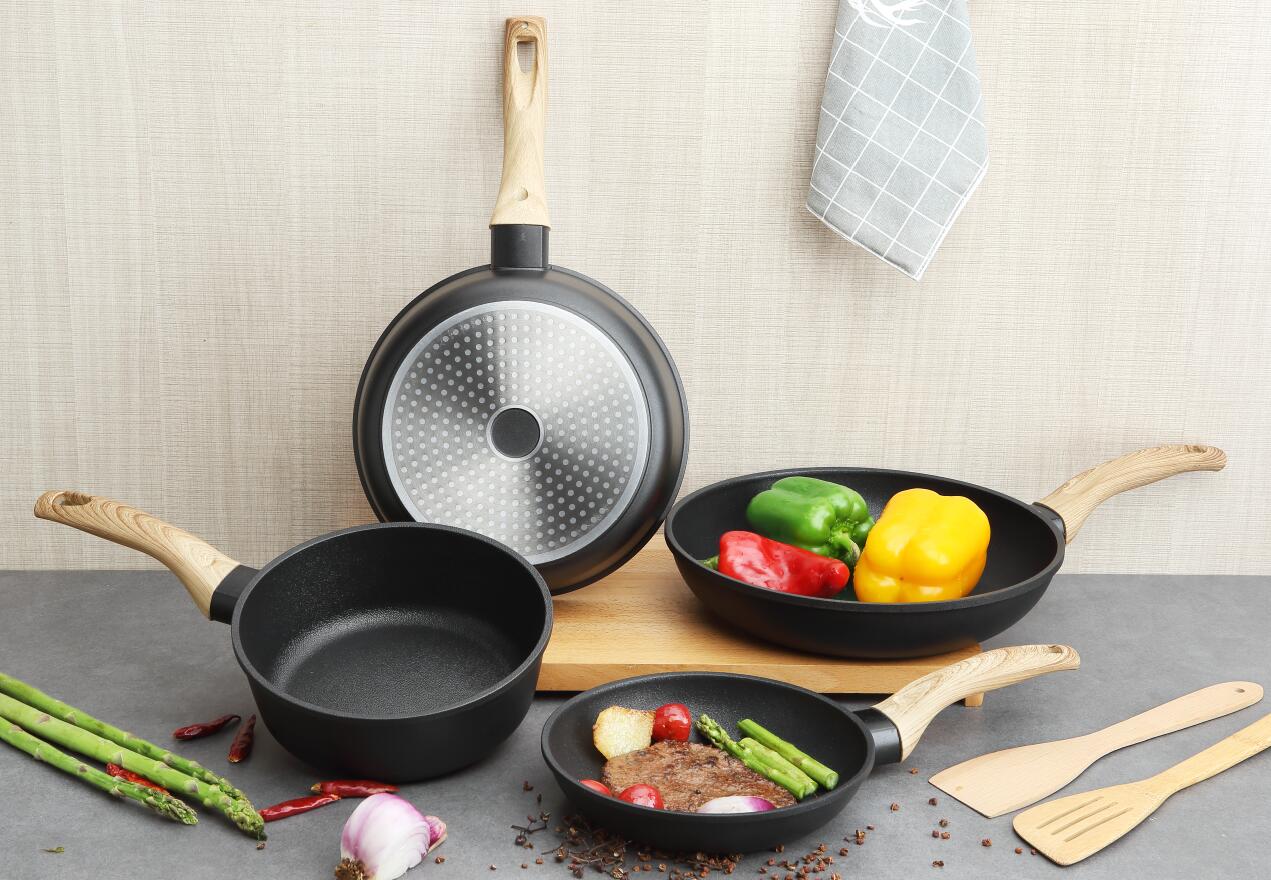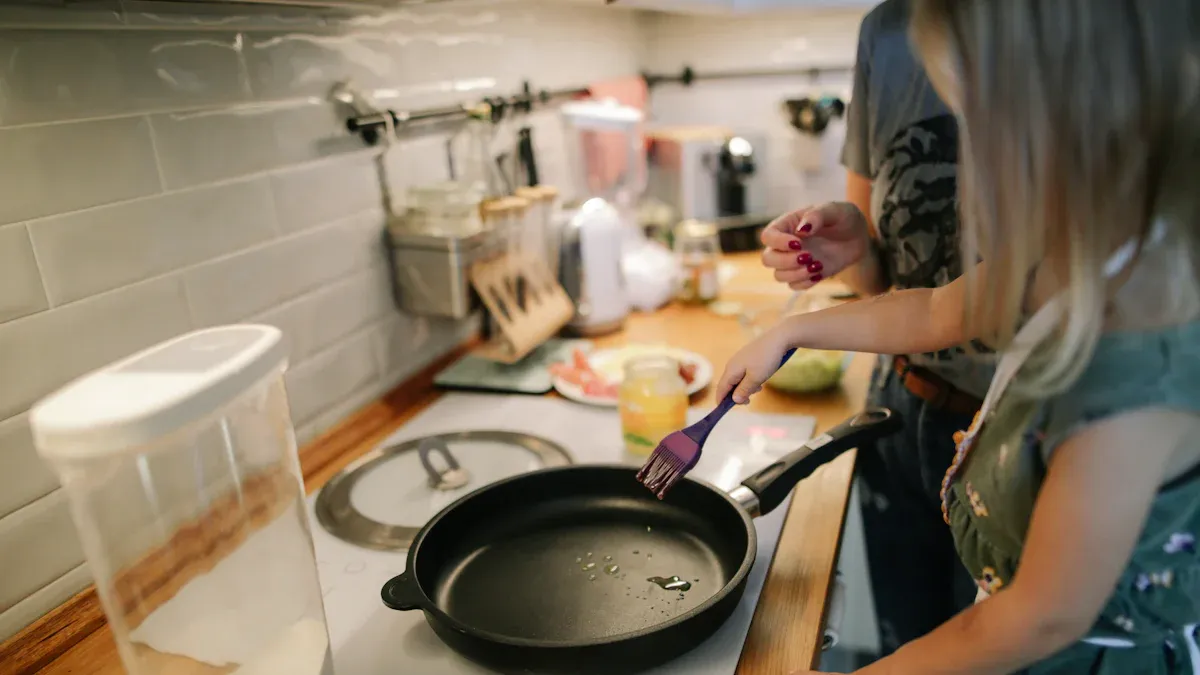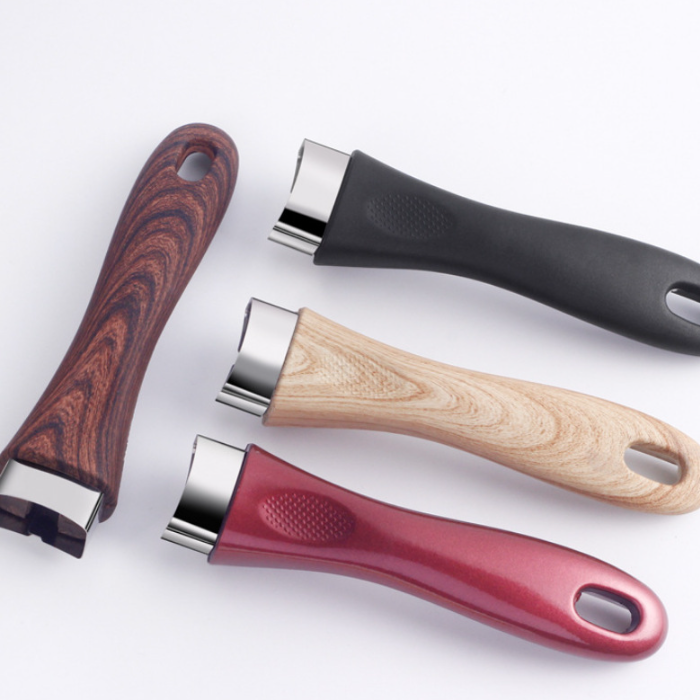 You may believe Bakelite is always the safest option for a cookware long handle. It resists heat and feels comfortable in your hand. However, Bakelite also has important limitations. > Many cooks discover that the best handle material depends on how you cook and what you value in safety.
You may believe Bakelite is always the safest option for a cookware long handle. It resists heat and feels comfortable in your hand. However, Bakelite also has important limitations. > Many cooks discover that the best handle material depends on how you cook and what you value in safety.
Key Takeaways
- Bakelite handles stay cool and feel comfortable but can crack or melt if exposed to high heat or dropped. Use them mainly for stovetop cooking at low to medium heat and avoid oven or broiler use.
- Different handle materials suit different cooking styles: stainless steel works best for high heat and oven use, silicone offers excellent heat resistance and grip, and wood provides comfort but needs careful care.
- Always check your cookware handles for damage and follow care instructions to keep them safe and lasting longer. Replace cracked or loose handles immediately to prevent accidents.
What Makes a Cookware Long Handle Safe?
Heat Resistance
You want a cookware long handle that stays cool while you cook. Good heat resistance keeps your hands safe from burns. Some materials, like metal, can get hot quickly. Others, such as silicone or Bakelite, help block heat. Always check if the handle can handle the temperatures you use most often.
Durability and Longevity
A strong handle lasts longer and keeps your cookware safe to use. If you drop your pan or use it every day, you need a handle that does not crack or break. Stainless steel and some plastics offer good durability. Handles that wear out fast can make your cookware unsafe.
Grip and Comfort
Comfort matters when you cook. A handle with a good grip helps you hold the pan steady. Some handles have shapes or textures that make them easier to hold. If your cookware long handle feels slippery or awkward, you might drop your pan or hurt yourself.
Toxicity and Chemical Safety
You should always think about what your handle is made of. Some materials can release chemicals if they get too hot. For example, some plastics may melt or give off fumes. Look for handles that are labeled as food-safe and heat-resistant. This helps keep your kitchen safer for you and your family.
Bakelite Cookware Long Handle—Strengths and Weaknesses
Heat Insulation Performance
You want a handle that keeps your hand safe from heat. Bakelite handles do a good job at blocking heat. You can hold the pan without feeling the burn, even when the pot is hot. Many people like Bakelite because it stays cool longer than metal. However, Bakelite has a limit. If you use high heat or put your pan in the oven, Bakelite can start to break down. It may even melt or crack if the temperature gets too high. Always check the safe temperature range before using your cookware long handle in the oven.
Tip: Never use Bakelite handles under a broiler or on open flames. High heat can damage them quickly.
Durability Under Stress and Heat
Bakelite feels strong in your hand. It resists scratches and does not rust. You can use it for many years if you treat it well. However, Bakelite does not like sudden shocks. If you drop your pan, the handle may chip or break. Repeated heating and cooling can also make Bakelite brittle over time. Some users notice cracks after a few years, especially if they use high heat often.
Here is a quick look at how Bakelite compares to other materials:
| Handle Material | Heat Resistance | Shock Resistance | Lifespan |
|---|---|---|---|
| Bakelite | Good (up to 350°F) | Fair | Moderate |
| Stainless Steel | Poor | Excellent | Long |
| Silicone | Excellent | Good | Moderate |
| Wood | Fair | Poor | Short-Moderate |
Grip and Ergonomics
You want a handle that feels good in your hand. Bakelite handles often have a smooth finish and a shape that fits your grip. Many people find them comfortable, especially for everyday cooking. Bakelite does not get slippery when wet, so you can hold your pan with confidence. Some brands add grooves or patterns to help you grip better. If you have small hands or arthritis, you may find Bakelite easier to hold than metal.
Toxicity Concerns and Myths
You may worry about chemicals in your cookware long handle. Bakelite is a type of plastic made from phenol and formaldehyde. When used properly, Bakelite is stable and safe. It does not release harmful fumes at normal cooking temperatures. Problems only happen if you overheat the handle. At very high temperatures, Bakelite can break down and release bad smells or smoke. You should avoid using damaged or burned Bakelite handles. Always follow the manufacturer's instructions for safe use.
Note: Some people believe Bakelite always releases toxins. This is not true if you use it within the safe temperature range.
Common Misconceptions About Bakelite
Many myths surround Bakelite handles. Here are some common ones:
- Myth: Bakelite never gets hot.Fact: Bakelite stays cool longer than metal, but it can still get warm after long cooking.
- Myth: Bakelite lasts forever.Fact: Bakelite can crack or chip if dropped or overheated.
- Myth: All black plastic handles are Bakelite.Fact: Some handles look like Bakelite but use cheaper plastics that do not resist heat as well.
You can use Bakelite handles safely if you know their limits. Always check your cookware for signs of wear and avoid high heat.
Cookware Long Handle Materials Compared

Stainless Steel Handles
You often see stainless steel handles on professional cookware. These handles feel strong and last a long time. Stainless steel does not rust or stain. You can use these handles in the oven and on the stove. They can get hot, so you should use a towel or oven mitt when you pick up your pan. Stainless steel handles work well if you want a cookware long handle that lasts for years.
Tip: Stainless steel handles are dishwasher safe and easy to clean.
Silicone Handles
Silicone handles stay cool and feel soft in your hand. You can grip them easily, even if your hands are wet. Silicone resists heat very well, so you do not have to worry about burns. Many pans use silicone covers over metal handles. You should check if the silicone is oven-safe before using it at high temperatures.
- Silicone handles come in many colors.
- They do not slip when you hold them.
Wooden Handles
Wooden handles give your cookware a classic look. They do not get hot quickly, so you can hold them without burning your hand. Wood feels comfortable and light. You should not put wooden handles in the oven or dishwasher. Water and heat can damage the wood over time.
| Handle Type | Heat Resistance | Comfort | Care Needed |
|---|---|---|---|
| Wood | Fair | High | High |
Plastic Composite Handles
Plastic composite handles use a mix of plastics for strength and comfort. These handles resist heat up to a point, but you should not use them in the oven. They can melt or warp if you use too much heat. Plastic composite handles often cost less than other types. You may find them on budget cookware.
Note: Always check the safe temperature range for any handle material.
Real-World Safety Concerns and User Experiences
Reported Issues and Recalls
You may wonder if cookware handles ever cause safety problems. Sometimes, manufacturers recall cookware because of handle failures. For example, some Bakelite handles have cracked or broken during use. This can lead to burns or dropped pans. Stainless steel handles rarely face recalls, but plastic and composite handles sometimes melt or detach. You should always check for recall notices on your cookware brand’s website. If you see cracks or loose screws, stop using the pan right away.
Alert: If your handle feels loose or wobbly, fix it before you cook again.
User Complaints and Praise
Many users share their experiences online. Some praise Bakelite handles for staying cool and feeling comfortable. Others complain about handles breaking after a few years. Stainless steel handles get mixed reviews. People like their strength, but some dislike how hot they get. Silicone handles often receive positive feedback for grip and heat resistance. Wooden handles get praise for comfort but complaints about wear and water damage.
Common user comments:
- “My Bakelite handle cracked after dropping the pan.”
- “Silicone handles never burn my hands.”
- “Stainless steel handles last forever, but I need a mitt.”
Longevity in Everyday Use
You want your cookware to last. Bakelite handles usually last several years if you avoid high heat and impacts. Stainless steel handles can last a lifetime with proper care. Silicone handles resist heat and wear, but may tear if you use sharp tools. Wooden handles need gentle cleaning and can dry out or crack. Plastic composite handles may warp or melt if you use them on high heat.
Tip: Always follow care instructions to extend the life of your cookware handles.
When Is Bakelite a Good or Bad Choice for Cookware Long Handles?
Best Uses for Bakelite Handles
You get the most from Bakelite handles when you cook on the stovetop at medium or low heat. Bakelite works well for frying pans, saucepans, and pots that never go in the oven. You can grip these handles easily, and they stay cool during most cooking tasks. Many people like Bakelite for daily meals because it feels comfortable and does not slip. If you want a cookware long handle that blocks heat and feels light, Bakelite is a smart choice.
Tip: Use Bakelite handles for boiling, simmering, or sautéing. Avoid using them for recipes that need high heat.
Situations to Avoid Bakelite
You should not use Bakelite handles in the oven or under a broiler. High heat can cause the handle to crack, melt, or release bad smells. If you often cook with high temperatures or need to finish dishes in the oven, pick another handle material. Bakelite also breaks more easily if you drop your pan. If you have a busy kitchen or kids who help cook, you may want a stronger handle.
Avoid Bakelite when:
- You bake or broil often
- You use high heat on the stove
- You need to wash cookware in the dishwasher
Matching Handle Material to Cooking Style
You should match your cookware long handle to the way you cook. If you love quick stovetop meals, Bakelite handles work well. If you bake, roast, or use high heat, stainless steel or silicone handles last longer. Wooden handles feel nice for gentle cooking but need extra care. Plastic composite handles cost less but may not last as long.
| Cooking Style | Best Handle Material |
|---|---|
| Stovetop, low/medium | Bakelite, Silicone |
| Oven, high heat | Stainless Steel |
| Gentle, classic | Wood |
Choose the handle that fits your kitchen habits. This helps you cook safely and enjoy your time in the kitchen.
You now know Bakelite is not a universal solution for cookware long handle safety. Its reputation comes from real strengths, but you should not trust it for high-heat or oven use. Always choose your cookware long handle based on your cooking habits and safety needs.
FAQ
How can you tell if your cookware handle is Bakelite?
Look for a hard, glossy black or brown handle. Bakelite feels cool and does not bend. If unsure, check the manufacturer’s label or website.
Can you put Bakelite handles in the dishwasher?
You should not put Bakelite handles in the dishwasher. Hot water and strong detergents can damage them. Always wash Bakelite handles by hand.
What should you do if your Bakelite handle cracks?
- Stop using the pan right away.
- Replace the handle if possible.
- Contact the manufacturer for advice or a replacement.
Post time: Jun-30-2025


